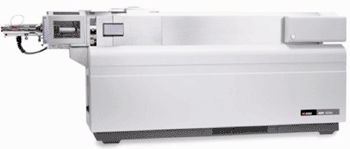Blood Test Determines Reduced and Oxidized Glutathione
By LabMedica International staff writers
Posted on 31 Jul 2013
Diminished levels of glutathione (γ-glutamylcysteinylglycine, GSH) and the ratio of GSH to glutathione disulfide (GSSG) can serve as important indicators of oxidative stress and disease risk. Posted on 31 Jul 2013
A simple and sensitive liquid chromatography-tandem mass spectrometry (LC–MS/MS) method for measuring whole blood GSH and GSSG has been developed and can easily be implemented in clinical laboratories.

Image: API 3000 triple-quadrupole mass spectrometer (Photo courtesy of Applied Biosystems).
Scientists at Stanford University School of Medicine (CA, USA) developed an approach that minimizes preanalytical variability through a one-step procedure of deproteinization and derivatization that prevents artifactual oxidation of GSH, and is easily adapted to the clinical setting without requiring excessive constraints on sample handling or storage. The team used anonymous, residual blood samples from 59 healthy individuals, 31 males, and 28 females, with an age range 1 to 87 years, with a mean of 25 years.
Compounds were separated by liquid chromatography using a Hypercarb column (Thermo Scientific; Waltham, MA, USA) at room temperature. The GSH and GSSG ions and fragments were detected using the API 3000 triple-quadrupole mass spectrometer (Perkin-Elmer; Waltham, MA, USA). The final concentrations of GSH and GSSG were expressed in units of μmol/L of whole blood.
The lower limits of detection (LLOD) were 0.4 μM for GSH and 0.1 μM for GSSG and the lower limits of quantitation (LLOQ) were 1.5 μM for GSH and 0.1 μM for GSSG. There was excellent linearity for both GSH and GSSG over the ranges of physiologic normal, with inter- and intra-assay coefficient of variation of 3.1% to 4.3% and accuracy between 95% and 101%. Derivatized samples are stable for at least three years when stored at -80 °C and underivatized samples for at least 24 hours at either 4 °C or room temperature. As a group, the mean concentration ± standard deviation for GSH was 900 ± 140 μM, GSSG 1.17 ± 0.43 μM, and GSH/GSSG ratio was 880 ± 370.
The authors concluded that their LC–MS/MS method minimizes preanalytic variability through a one-step procedure of deproteinization and derivatization, and chromatographic conditions that eliminate ion suppression and increase precision and sensitivity. Additional advantages included the small sample requirement, simple and rapid preanalytical processing, and wide automation possibilities, which makes this method ideal for routine and large-scale clinical testing. The study was published on June 15, 2013, in the Journal of Chromatography B.
Related Links:
Stanford University School of Medicine
Thermo Scientific
Perkin-Elmer














